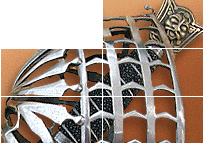| Author |
Message |
|
Lucas Simms
Location: Washington Joined: 14 Mar 2010
Posts: 33
|
 Posted: Thu 25 Mar, 2010 4:59 pm Post subject: 16th century tasset construction Posted: Thu 25 Mar, 2010 4:59 pm Post subject: 16th century tasset construction |
 |
|
I always wondered:
Are the lames on the "inner" thigh attached to each other the same way as the ones on the "outer" thigh?
If so, are the leather strips used only as reinforcement?
Thank you in advance
 Attachment: 79.96 KB Attachment: 79.96 KB
rivet heads on the outside of the lames [ Download ]
 Attachment: 83.75 KB Attachment: 83.75 KB
inside showing leather strips [ Download ]
Lucas
|
|
  |
 |
|
Allan Senefelder
Industry Professional
|
 Posted: Thu 25 Mar, 2010 5:29 pm Post subject: Posted: Thu 25 Mar, 2010 5:29 pm Post subject: |
 |
|
|
Lucas, the outside edge is most always on sliding rivets rather than leathers as the need for compression is on the inside and center of the thigh rather than the outside of the thigh.
|
|
   |
 |
Matthew Fedele

Location: Auburn, NY USA Joined: 21 Jul 2005
Posts: 64
|
 Posted: Thu 25 Mar, 2010 5:59 pm Post subject: Posted: Thu 25 Mar, 2010 5:59 pm Post subject: |
 |
|
What Allan said and if you want to build them like your life depends on them, a backup strap in the center.
 Attachment: 91.66 KB Attachment: 91.66 KB
[ Download ]
|
|
   |
 |
|
Allan Senefelder
Industry Professional
|
 Posted: Fri 26 Mar, 2010 5:40 am Post subject: Posted: Fri 26 Mar, 2010 5:40 am Post subject: |
 |
|
|
Another note Lucas, the rivest you've highlighted in the first pic are actually blind ( they are not through both plates, they are not attaching anything they're just filling a whole ) and not the rivets holding the straps in which would be flush riveted on the underlap of each plate. Blind rivets are either a) filling a hole that was needed while building to make the plates match up in terms of shape, but not necessary for ariculation b) simply to maintain symetry between the outside edge, which will most always have an articulating rivet, and the inside edge which deosn't need them c) occasionally to fill in holes mistakenly located. In this case as the cuvre is not sever B would propabaly be the case.
|
|
   |
 |
|
|

